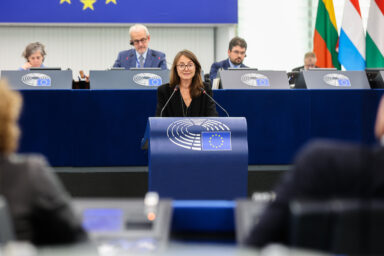A maximum of three litters per dog or cat within two years, and no painful surgeries. Those are the main points of the new Dog and Cat Welfare Regulation. The law primarily responds to the phenomenon of pet trafficking on the Internet and the boom in so-called breeding centres. But ordinary owners will not be burdened by the rules, says the rapporteur for the regulation, MEP Veronika Vrecionová (ECR/CZE).
You are the rapporteur for the proposal. What’s the objective of the legislation?
In Europe, we are experiencing a boom in interest in pets. Pets are not a thing, but their sale operates on the principle of the market, and specifically in EU countries within the EU common market. Therefore, we need minimum common rules for certain matters relating to these pets, so that there is a level and fair playing field in the common market. At the same time, we need to protect these pets in a situation where a new phenomenon of online pet trade has emerged and breeding facilities that are linked to the illegal pet trade are flourishing across Europe.
What are the key points of the proposal?
The regulation improves the living conditions of dogs and cats. At the same time, it does not burden ordinary breeders with unnecessary restrictions. The proposal, as it has now passed through committee, it includes a ban on cruelty and permanent tethering, and also prohibits painful procedures such as cupping, declawing or vocal cord removal. Similarly, there is a ban on inbreeding or on breeding animals with extreme traits leading to suffering. Animals with these extreme traits will also no longer be allowed to take part in dog shows, so that breeders are not ‘incentivised’ to cause that sort of suffering.
Linking databases across the EU
The provision imposing penalties on member states is also important.
In addition to improving animal welfare, the proposal includes a number of measures against breeding farms and illegal trade. For example, we have adopted a rule that a dog or cat can have a maximum of three litters in two years. And these litters must be followed by a break of at least one year.
To my delight, the creation of linked national databases across the EU also made it into the proposal. This will allow online verification of an animal’s origin throughout the Union. This European database is also linked to the fact that compulsory microchipping for cats placed on the market by ‘professional’ sellers appears in the regulation. This would make no sense without the database. This is also linked to the measures for imports from third countries – they will have to meet the same living conditions and be registered within two working days of entering the EU.
You might be interested
Main objective? Fight illegal trade
How will the regulation affect ordinary dog and cat owners?
This regulation does not apply to ordinary dog and cat owners, but only to breeders, dealers and shelters — that is, people and entities that trade in animals. What is important in this respect is that the proposal making it compulsory for all cats to be chipped, including those owned by ordinary pet owners or ordinary country cats, has been prevented from being adopted. This would have placed greater demands on their owners and would not have helped much in one of the main objectives of this regulation — the fight against the illegal trade in animals and against breeding.
Last Tuesday the EP’s Agriculture Committee voted its position on the legislation. What are the main differences from the original proposal?
During the discussion in the European Parliament committee, we added a so-called review clause to the proposal, where the Commission will have to evaluate the impact of the adopted regulation after a certain period of time and, if necessary, propose amendments to it. At the same time, we have corrected a number of inaccuracies contained in the Commission’s proposal.
To chip or not to chip
What will be the main points of discussion in the trialogues?
I suppose that most talked about will be the form of the aforementioned cat chipping. In the committee, we approved a moderate proposal to make it compulsory to chip only cats placed on the market by a dealer. However, some countries already have this obligation across the board, and some animal welfare organisations are also pushing for universal chipping.
Why should this matter be dealt with at European level?
We have a common market in which animals are traded. I am not in favour of the EU regulating everything in every detail for the member states. But there are certain, and I stress minimum, rules needed to protect dogs and cats and to make the market safe and fair. Moreover, we have chosen a compromise path where, in order to meet these objectives, we do not burden ordinary people who have a four-legged friend at home for pleasure and not for business.











